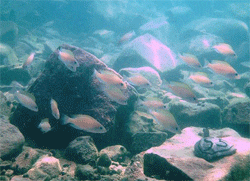Understanding the rationale for adoption has challenged theorists for generations. Franziska Schaedelin and colleagues at the University of Veterinary Medicine, Vienna now describe a new approach to the problem. The scientists present findings that suggest parents of fish exchange young with other parents to reduce the chances that their entire brood will be predated. The results are published in the current issue of the journal “Behavioral Ecology”.

The phenomenon of adoption has taxed the minds of evolutionary scientists since Darwin first came up with his account of natural selection. According to Richard Dawkins’s description, adoption is “a double whammy. Not only do you reduce, or at least fail to increase, your own reproductive success, but you improve someone else's.” So why are animals apparently so willing to take care of young that are not related to them?
Franziska Schaedelin and colleagues at the Konrad Lorenz Institute of the University of Veterinary Medicine, Vienna now shed interesting light on the problem. The researchers are investigating a small cichlid fish that lives in Lake Tanganyika in southern Africa. The species is monogamous and pairs construct nesting caves to protect their eggs and fry from predators. By diving 12 meters to the lake floor, the scientists were able to collect DNA samples from over 350 parents and fry from over 30 nests. Sophisticated genetic techniques were then applied to investigate the parentage of fry in individual nests.
Most nests were found to contain fry that were unrelated to both “parents”, with some nests containing fry produced by several pairs of parents. Because the locations of the nests were known, the scientists were able to show that fry had been born in nests that were separated by less than one metre to over 40 metres from their adoptive nests. Although very small fry may be able to swim several metres to a new cave without being eaten, it is highly unlikely that they could travel much longer distances.
Instead it is probable that they were carried to new nests in the mouths of their parents, a mode of transport that is known to occur in cichlids. Transporting the fry to fairly distant nests would ensure that some young are protected even if all the nests in the immediate neighbourhood are predated or destroyed, so it is easy to rationalize why parents should do this. But why should other fish be willing to adopt fry that are unrelated to them?
Schaedelin suggests that foster parents may accept unrelated fry as a way of diluting predation of their own offspring. If this is so, parents should adopt fry that are not larger than their own young, as smaller fry are known to be predated first. The researchers were indeed able to show that adopted fry were the same size as native fry within broods, although they were generally larger than fry that were not offered out for adoption. It seems that parents selectively allow unrelated fry to assimilate into their own broods while also delivering their fry for adoption by others.
Sharing the care of broods among different families thus represents a kind of insurance policy against the predation of a nest. Schaedelin summarizes the findings neatly: “in a species that is so highly predated, it must have been important to develop a strategy to ensure that at least some of the young survive. It seems that fish do this by not putting all their eggs (or young) in one basket.”
May 2013




